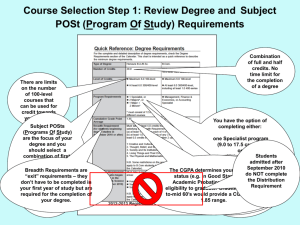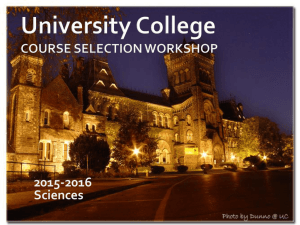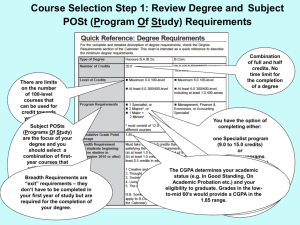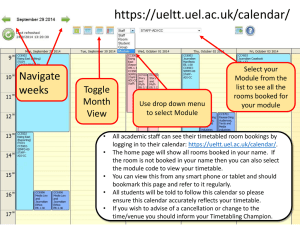1 st year required courses
advertisement
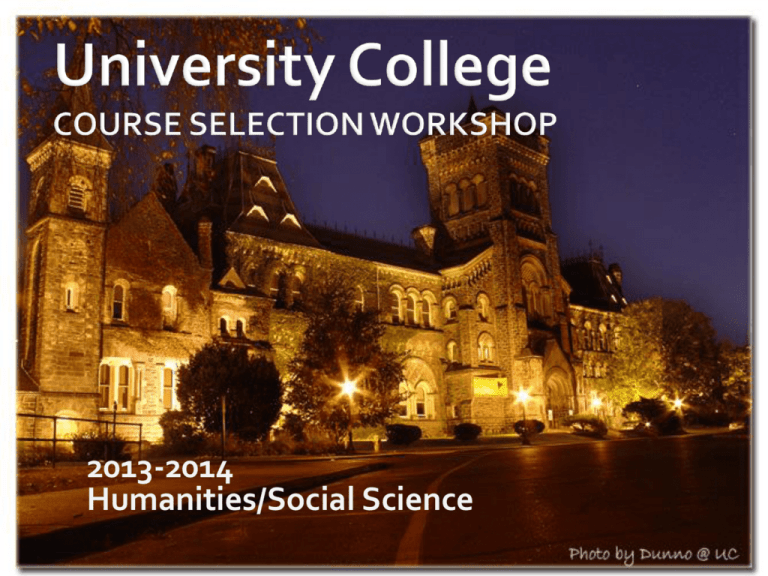
2013-2014 Humanities/Social Science 1. Introduction 2. Materials for choosing courses 3. Steps to choosing courses 4. Important Dates 5. Registration & Fees 6. Keys to Success On the Arts & Science website: www.artsci.utoronto.ca New Students site 2. Academic Calendar 3. Registration Instructions and Timetable 1. www.artsci.utoronto.ca Home Welcome Guide Calendar FASt Answers Next Steps Course Selection Program Information list of all programs and 1st year required courses www.artsci.utoronto.ca Programs and Courses Example: Anthropology Important Notices Code of Behaviour on Academic Matters Code of Student Conduct Grading Practices Policy Policy on Official Correspondence with Students Important Dates Drop deadlines Student Services & Resources Degree Requirements Breadth Requirements Rules and Regulations LWD, CR/NCR, GPA etc. Course code PHY131H1 Campus code indicator. 1 = course offered on the St. George campus Y 1.0 level credit, H = 0.5 credit First digit indicates = year PHY = Departmental Identifier Introduction to Physics I Course title A first university physics course primarily for students not intending to pursue a Specialist or Major program in Physical or Mathematical Sciences. Topics include, classical kinematics & dynamics, momentum, energy, force, friction, work, power, angular momentum, oscillations, fluids, viscosity. Course Description Prerequisite: MCV4U Calculus and Vectors/MCB4U Functions & CalculusLists courses with similar course content. If you have taken a course listed as an Recommended Preparation: SPH4U Physics and SCH4U Chemistry Lists coursesexclusion, you must then have you can’t completedtake before you canfor credit Corequisite: MAT135H1/137Y1/157Y1 PHY131H1 Lists courses that are recommended by the take PHY131H11 Department as pre-requisites or coCourse is a Breadth Requirement DR =SCI, BR = 5 for but not required Lists coursesrequisites that must bePHY131H1, taken 5 ‘The (BR) from Category concurrently withMathematical Physical and PHY131H1 Universes’ Exclusion: PHY151H1/110Y1/138Y1/140Y1 www.artsci.utoronto.ca Quick Links Timetable Listings Important dates Registration Instructions Detailed instructions on choosing your courses Explanation of codes, wait lists, how to use ROSI Fees information Timetable listings Evening courses 1st Year Seminars Courses not offered *Map and Building Codes* indicates Several Lecture, ‘F’‘H’ section code indicates 0.5 credit Practical andplace Tutorial course takes in First Meeting Sections to Term – Sept. to Dec. choose from. You must choose one of each typeSection if offered Meeting codes (not every course will time correspond to specific offer and takes slots e.g.Practical Lecture L0201 Tutorial Meeting place on Tues. (‘T’), Thurs. Sections) (‘R’) and Fri (‘F’), from 12:10 till 1:00 p.m. (Classes begin 10 minutes after the hour and end on the hour.) Practical (lab) P0401 takes place on (‘R’) Thurs. from 2:10 till 5:00 p.m. A general location on campus is provided for first-year courses to assist you in planning your aacademic timetable. Avoid Some courses will offer back-to-back East/West classes as it is waitlist option if the meeting Enrolment Indicators and Controls difficult to travel section is filled. A ‘Y’ indicator give access to a course to specific across campus in the 10 minute interval between classes means that a waitlist function groups of students (A) Indicates that for the specific Practicaltimes (lab) Meeting Section takes is available on ROSI and some courses – those with ‘E’ week. This may allow place in alternate weeks, not every Enrolment Indicators cannot be you to create a more “efficient” timetable by selecting a added via ROSI/SWS Practical Meeting Section for a first-year science course that will alternate - in the same time slot - with a Practical Meeting Section in another first-year science course. e.g. CHM138H1 (F) P0201 (Tues. 2:10-5:00) will alternate with BIO120H1 (F) P0202 (Tues. 1:30-4:30). ( Refer to Timetable for more details. ) September ------------------------------- December January ------------------------------------------ April H Course Code (0.5 credit) H Course Code (0.5 credit) F Section Code = First Term S Section Code = Second Term Y Course Code (1.0 credit) Y Section Code = Full ‘Year’ (Sept. – April) Y Course Code (1.0 credit) Y Course Code (1.0 credit) F Section Code = First Term S Section Code = Second Term H Course Code (0.5 credit) Y Section Code = Full ‘Year’ (Sept. – April) HIS103Y1Y Notes re: 100-series courses, tutorials etc. Link to Calendar description Enrollment Indicator and Control info + link to explanations RLG100Y1Y No Enrollment controls Tutorial listed with Lecture hours EAS100Y1Y Special instructions for language courses ECO100Y1Y Note for Commerce sections No mention of tutorials in timetable, but they are listed in the Calendar description when you go to the link 1. Review Degree requirements 2. Review Subject POSt/program options 3. Find your 1st year required courses 4. Consider your elective options 5. Check course descriptions in the Calendar 6. Check course information in the Timetable 7. Create a list of courses and schedule with back up choices 8. Check the A&S website for any updates 9. Enroll on ROSI There are limits on the number of 100-level courses that can be used for credit towards your degree Subject POSts (Programs Of Study) are the focus of your degree and you should select a combination of firstyear courses that will giveRequirements you the Breadth are option to enter “exit” requirements – they several don’t have different to be completed in Subject the but are your first POSts year ofatstudy end of your firstcompletion year required for the of ofyour study degree. Combination of full and half credits. No time limit for the completion of a degree You have the option of completing either: one Specialist program (9.0 to 17.5 credits) or two Major programs Students (6.0 to 8.0 credits each) after orYou can complete moreadmitted than September 2010 oneCGPA Majordetermines program The the “minimum” your academic number of do NOT complete (6.0 to 8.0 credits) status (e.g. Subject In Good POSts. Standing, You can Onselect the Distribution plus Academic up Probation to 3 Subject etc.) POSts and your with a Requirement two Minor programs eligibility to graduate. maximumGrades of 2 large in the Subject low(4.060’s credits each) to-mid would POSts provide ( e.g. a CGPA Majorsinorthe 1.85 range. Specialists). Must take at least 4.0 credits from the following categories: take at least 4.0 credits from the following categories: 1. Creative and Cultural Representations (CCR) 2. Thought, Belief and Behaviour (TBB) 3. Society and Its Institutions (SII) 4. Living Things and their Environment (LTE) 5. The Physical and Mathematical Universes (PMU) Note the specific requirement for Commerce Students Credits must be either: a) 1.0 credit in each of 4 of the 5 categories; or b) 1.0 credit in each of 3 of the 5 categories and 0.5 in each of the other 2 categories **Commerce students must complete at least 1.0 FCE from Category 1 **Other restrictions/rules also exist (see Calendar – ‘Degree Requirements’) Start with the listing of Subject POSt options on the New Students website under ‘Course Selection’ Most Subject POSts will have one or more required first-year courses and you should select your combination of 5.0 first-year credits carefully to ensure that you will have access to a variety of Subject POSt options at the end of your first year of study. More detailed Subject POSt information, including firstyear required courses, can be found in the Arts and Science Calendar. Economics Major (Arts program) This is a limited enrolment program. Space permitting, students who request the program and obtain at least the specified mark(s) in the required course(s) will be eligible to enroll. Achieving these marks does not necessarily guarantee admission to the program in a given year. Symbols in the Calendar: Required courses and grades for program enrolment: (ECO100Y1 with a final mark of at least 67%, or ECO105Y1 with a final mark of at least 80%), AND / means ‘OR’ MAT133Y1 with a final mark of at least 63%, or ; , MAT136H1 + ( ) & all (MAT135H1 with a final mark of at least 60% and withmean a final ‘AND’ mark of at least 60%), or MAT137Y1 with a final mark of at least 55%, or MAT157Y1 with a final mark of at least 55%. Program Course Requirements: 7 full courses or their equivalent First Year (2.0 FCE): ECO100Y1/ECO105Y1; MAT133Y1/(MAT123H1,MAT124H1)/(MAT135H1,MAT136H1)/MAT137Y1/MAT157Y1 Step 4: Consider Elective Course Options 1. Courses that can help fulfill the Breadth Requirement: • The required courses for your programs of interest will fulfill some of your breadth requirement. • You don’t have to complete the Breadth requirement in 1st year, but it can be a good opportunity to take an elective course in a category you need 199 Seminars Big Ideas courses Courses from the Calendar (examples): BR= 4 Anthropology (ANT100Y, BR= 3+4) Environment (ENV200H) Geography (GGR101H) BR=5 Courses for non-science students: Astronomy(AST101H, 121H, 201H) Chemistry (CHM101H) Geography (GGR100H) Earth Sciences (ESS103H, ESS105H, ESS205H) Mathematics (JUM205H) Physics (PHY100H, PHY101H, PHY201H, PHY205H) Step 4: Consider Elective Course Options 1. Courses that can help fulfill the Breadth Requirement: 4. Introductory courses that will give you additional Subject POSt options: • The required courses for your programs of interest will fulfill some of your breadth requirement. • • You don’t have to complete the Breadth requirement in 1st year, but it can be a good opportunity to take an elective course in a category you need It is important to have several options for Subject POSts at the end of 1st year in case your first choice is not what you expected or you do not achieve the grade needed to enter the program • Taking an additional introductory course allows you to explore other interests you may have 2. Small class experiences – 199 courses, FLCs, Foundational Year Programs, eg. UC One 5. Explore something that wasn’t available in high school or that may help towards future goals: • These are unique opportunities only available in your 1st year, including a chance to get to know your professor - each class usually has no more than 25 students • The advantage of being at a university as large as U. of T. is the huge selection of courses • Professional programs (medicine, law, social work etc.) generally focus on marks and not program choices, but may suggest some courses to take during your undergraduate years • 199 courses are designed to help fulfill the breadth requirement and you should ideally choose one in a category that is different from your main programs of interest 3. Skills development courses – e.g. writing courses and languages: • • Courses such as Effective Writing (ENG100H1) or Writing Essays (INI103H1) can help build skills that will be valuable for other courses you take U. of T. offers over 40 different languages to learn 6. Anti-Calendar - available online at www.assu.ca: • Consider what other students have thought of courses • The Anti-Calendar is published by the student union and provides student evaluations of courses and professors to help students make informed choices PHY131H1 Introduction to Physics I A first university physics course primarily for students not intending to pursue a Specialist or Major program in Physical or Mathematical Sciences. Topics include, classical kinematics & dynamics, momentum, energy, force, friction, work, power, angular momentum, oscillations, fluids, viscosity. Exclusion: PHY151H1/110Y1/138Y1/140Y1 Prerequisite: MCV4U Calculus and Vectors/MCB4U Functions & Calculus Recommended Preparation: SPH4U Physics and SCH4U Chemistry Corequisite: MAT135H1/137Y1/157Y1 DR =SCI, BR = 5 Make sure you check all Exclusions, Pre-requisites, Co-requisites for all courses you plan to take Make sure you understand any Enrolment Indicators and Controls Ensure you have checked instructions at the beginning of the section for any that apply to you Peace, Conflict and Justice Studies 1. 2. 3. HIS103Y1/ECO100Y1/105Y1; (PSY100H1+220H1)/SOC101Y1; POL208Y1 (optional in 1st year) English 1. 2. 3. 4.0 FCEs Recommended: 1.0 100-series ENG = ENG140Y1/ENG150Y ENG 200-level (optional) Ethics, Society and Law International Relations (Trinity College program) 1. ECO100Y/105Y1; 2. HIS103Y1 or TRN 150Y1/151Y1 or two of VIC181H1, 183H1, 184H1, 185H1 3. One introductory modern language course or MAT133Y/137Y1 (for specialist) -See additional notes listed Sociology (Trinity College program) 3.0 FCEs selected from 100-level courses that count under the Faculty’s Breadth Requirement as Category 2 or 3 *expected required average grade of B 1. 1. SOC101Y1 or (SOC102H1+SOC103H1) with a minimum grade/average grade of 65% 1. ECO100Y1Y, L5101 * BR =3 2. HIS103Y1Y, L0101 * BR =3 3. ENG150Y1Y, L0201 * BR =1 4. SOC101Y1Y, L0101 or SOC102H + SOC103H * BR =2+3 * BR =3 5. LTE199Y1Y, L0361 * BR =4 Program options at the end of 1st year: 1. Peace and Conflict – SPE/MAJ, Joint - SPE 2. Int’l Relations – MAJ 3. English – SPE/MAJ/MIN 4. Sociology – SPE/MAJ/MIN 5. Criminology – SPE/MAJ 6. Employment Relations – SPE/MAJ 7. Canadian Studies – SPE/MAJ 8. and more….. Monday Tuesday Wednesday Thursday Friday 9:00-10:00 10:0011:00 ENG150Y L0201 ENG150Y L0201 11:0012:00 ENG150Y L0201 (t) 12:00-1:00 SOC101Y L0101 1:00-2:00 2:00-3:00 HIS103Y L0101 3:00-4:00 4:00-5:00 5:00-6:00 6:00-9:00 ECO100Y L5101 LTE199Y1Y L0361 “Time” HIS103Y L0101 XBC199Y1 L0241 *alternate* Elective courses selectedCourses to fulfill selected additional Make timetabling easier by to theof firststmeet scheduling the 1breadth choice year requirements; Lecture/Practical/Tutorial Meeting requirements Sections for all 5.0 provide credits before for2entry to nd or 3 rd attempting to alternate/back-up schedule your preferred program options; choice “back-up” meeting sections Subject POSts for the for eachallow course. acquisition of new skills etc. List your 5.0 credits in order of priority. You select all of your First Term, Second Term and Full Session courses when you log on to ROSI at your assigned Try to selectstart 2nd and 3rd choice “back-up” time. Meeting Sections in the event that your first choice of Lecture/Practical/Tutorial is filled. Ensure that these “back-up” You may take 200-level (second year) options do not create timetable conflicts courses incourses your first year of study Choose alternate or back-to-back East/West difficulties provided that you in the event that youhave the appropriate background corequisites cannot obtain a (prerequisites, space in etc.)ofbut 200-level one your first 5.0courses are generally more difficult and demanding than 100preferred courses level courses Mon Tues Wed Thurs SPA100Y1 (Y) L0401 East SPA100Y1 (Y) L0401 East PMU199H1 (F) L0342 11:00 – 1:00 SPA100Y1 (Y) L0401 East Fri 9:00 – 10:00 10:00 – 11:00 11:00 – 12:00 12:00 – 1:00 1:00 – 2:00 ENG140Y1 (Y) L0201 East Tutorial 1:00 – 2:00 2:00 – 3:00 ENG140Y1 (Y) L0201 East Lecture 2:00 – 4:00 3:00 – 4:00 HIS102Y1 (Y) L0101 Central HIS102Y1 (Y) L0101 Central 4:00 – 5:00 5:00 – 6:00 6:00 – 7:00 SOC102H1 (F) L5101 Central 6:00 - 8:00 Blank ‘Weekly Schedule’ forms are provided in Timetable Sometimes there are time changes and/or cancellations Check the Faculty of Arts and Science’s timetable website periodically to see if there have been any changes made to the time or location of classes you wish to enroll in www.rosi.utoronto.ca Also known as the SWS First time users: PIN is your date of birth format: yymmdd Check to be sure your ‘mail. utoronto.ca’ address is listed on ROSI Once you have made your schedule, you go online on July 30th at your start time to add your courses: Course selection demo www.rosi.utoronto.ca July 22 – Check start time for first year students July 30 – Course enrolment begins for first year students July 31 (6 am) – Seminar courses open to all (except those that have college membership as an additional enrolment control—p.221 Handbook) Aug. 8 (6 am) – “P” enrolment control removed Aug. 7, 12, 14 & Sept. 6 – No course enrolment on ROSI Aug. 8 – Sept. 22 – Open course enrolment period for F/Y section code courses Aug. 8 - Jan. 19 – Open course enrolment period for S section code courses Fees Invoice – on ROSI (“Financial Accounts”) REGISTERED vs. INVIT (Check on ROSI/Timetable) Deadline – August 20th Minimum payment at the bank; telephone/online banking OSAP deferrals (on ROSI), Scholarships (Registrar’s office) Third-Party Payments (e.g. RESP) After August 20th: You will lose your courses if you have not completed your registration! Bring in proof of payment to the Registrar’s Office immediately Plan your finances – so you have enough money for the year. Fees are higher for Commerce in 2nd, 3rd and 4th years Incidental fees vary by college Check the refund schedule on the website For course changes – 100% refund in the 1st two weeks of classes For program fee: your status as FT or PT is fixed as of Sep 22nd F + Y courses (Sep 22nd) + S courses (Jan. 19th ) = course load 0.5 - 2.5 FCEs = PT 3.0 - 6.0 FCEs = FT Time Management Getting the Right Books *Booklist available around mid-August online or at the U of T bookstore Attend All Your Classes and tutorials Ask Questions! Registrar’s Office Departments Professors and TAs—office hours UC Writing Centre, Math lab, ECO lab, Academic Success Centre Have Remote Back Ups of All Files (USB key etc.) Keep All Completed/Returned Tests and Assignments Know the Rules and Regulations (Calendar) Academic Integrity Pay Attention to Dates and Deadlines (Calendar & Timetable) Be in ‘good standing’ (CGPA 1.50+) COURSE MARK GPA Credit Value ENG 150Y1Y HIS 103Y1Y ECO 100Y1Y 77% 79% 69% 3.3 3.3 2.3 1.0 1.0 1.0 XBC 199Y1Y SOC 102H1F 75% 67% 3.0 1.0 2.3 x 0.5 = 1.15 0.5 SOC103H1S 71% 2.7 x 0.5 = 1.35 0.5 Final GPA 14.40 5.0 (14.40÷5.0) 2.88 University College Registrar’s Office 15 King’s College Circle, Room 157 Toronto, ON M5S 3H7 Tel.: (416) 978-3170 E-mail: uc.registrar@utoronto.ca Hours of Operation Mon-Fri: 10am to 12:00pm and 1:30pm to 4:00pm Have a great summer!


